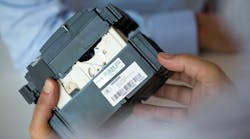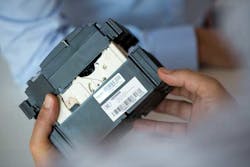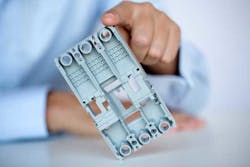High-Performance Polyamides Open Up New Opportunities for MCCB Manufacturers
What is driving the trend toward the use of low-voltage molded-case circuit breakers, or MCCBs?
Dufour: First of all, we see a growing need for energy conservation through electronic regulation of large-area electrical networks (so-called “Smart Grid/Smart City” technology), which low-voltage MCCBs—MCCBs for systems operating at below 690 V ac—help meet. Secondly, the increasing electrification of rural areas in the developing world, sometimes through solar-energy generation methods, as well as the continued growth of mass-transit systems in urban areas globally, stimulates the need for dc MCCBs.
Wong: Virtually all MCCBs are made today in glass-reinforced thermosetting polyesters, or bulk molding compounds (BMCs), but you propose that it is now possible to use certain types of polyamide, a thermoplastic, instead. Very briefly, tell us the difference between a thermoset and a thermoplastic, and why the market should want to change. Is there something wrong with BMCs?
This file type includes high resolution graphics and schematics when applicable.
Dufour: You are right, the vast majority of MCCBs produced today use cases made from BMCs. Thermosets are plastics that undergo an irreversible chemical curing action upon molding, changing the resin permanently from a liquid to a solid. Thermoplastics, on the other hand, undergo no chemical reaction, with heat only serving to soften them and enabling them to flow and fill the product cavity in the molding process.
Switching to engineering thermoplastic (ETP) solutions offers advantages in terms of performance and economics, as well as aesthetics, which even in industrial products like this are important. MCCBs with open arc extinguishing chambers made with ETPs, such as high performance polyamides offered by DSM, can achieve higher electrical endurance ratings. Together with our industrial partners, this has been proven up to Icu (ultimate breaking capacity)/Ics (service breaking capacity): 100 kA/75 kA with 400 V. The low yearly volumes usually associated with highly rated systems do not make the use of ETPs very competitive. But for the lower-rated systems, ETPs enable MCCB producers to improve their process economics—DSM has calculated that up to 10-15% system cost reductions are feasible—and gain a stronger market position.
Besides functional gains, we see that ETPs also facilitate new, integrated designs with lower wall thicknesses. This, among other possible advantages, enables new and more modern designs, which in turn create competitive advantages in this market. For the manufacturing part, higher productivity in molding is commonplace, adding to competitive advantage.
The much greater ease with which ETPs can be recycled also plays a role in their acceptance in this application. Any scrap or rework in production can be put back into the process, which is not possible with thermosets.
Related to this, DSM’s ability to offer many of its grades in halogen-free, flame-retardant formulations is very much in line with the trend for more sustainable materials in the electrical and electronics industries.
Wong: I think there is more than one polyamide on the market. And are we talking about any polyamide for this application, or a very specific one? What makes one polyamide different from another anyway?
Dufour: Different parts in the MCCB have different performance requirements and therefore call for different material properties. The requirements originate both from the industrial standards, either UL or IEC, and often complement the requirements derived from specific designs or requirement profiles. A very common polyamide is polyamide 6 (or PA6), but most MCCB components require performance that PA6 cannot provide. For this, there are higher performance products like PA46 and PA4T.
Wong: There are lots of thermoplastics on the market today. Are these polyamides the only ones that fit the bill? For example, what about materials like PBT, which are widely used in electrical devices?
Dufour: The requirements for MCCB parts are very stringent, and in these applications PBT falls short in terms of thermo-mechanical and electrical performance, especially in advanced designs. As I said, not even PA6 is good enough for some MCCB components. That’s why DSM, for example, has developed a special PA46 compound that significantly improves the arc quenching performance of an MCCB and offers higher residual isolation resistance after (repetitive) short circuits due to lower soot formation. Both contribute to the improved safety and performance of the MCCB.
Wong: Are we talking about a simple container for the MCCB, or do these materials have to perform more functional tasks?
Dufour: We are talking about several components in the MCCB, each with its own requirements in terms of thermo-mechanical and electrical performance. It is now possible to choose polyamides for tripping bars, tripping unit parts, and chamber materials, besides the base and intermediate or top cover of the device. For parts with the most demanding requirements, a relatively new polyamide, PA4T, provides exceptional characteristics.
Wong: Are all MCCBs the same?
Dufour: No, you have different types of MCCBs depending on the purpose, e.g. domestic, industrial, institutional, for mass-transit applications etc. They also vary in their electrical characteristics and number of terminals. In all cases, polyamides are now available to replace the thermosetting compounds that have been used until now.
Wong: If I am producing MCCBs today in BMC, am I going to have to invest a lot to change to polyamide 46? Can I use the same equipment?
Dufour: BMCs and polyamides are both processed on injection molding machines, but the characteristics of the machines and molding tools are quite different, so you will need to make some changes to your equipment park. But the investment is worthwhile if you consider the cost savings and design benefits you can make in production. As I said, these can be as much as 10-15%.
This file type includes high resolution graphics and schematics when applicable.
Peter Dufour is global marketing manager for the electrical industry within the Engineering Plastics group of DSM—a global Life Science and Materials Science Company, which is involved in (bio-based) polyamides and polyesters serving the electrical and electronics, automotive, flexible food packaging, and consumer goods industries. He has up to 30 years’ experience within DSM, and holds a bachelor’s degree in chemical technology from the Hogeschool of Rijswijk, the Netherlands.





